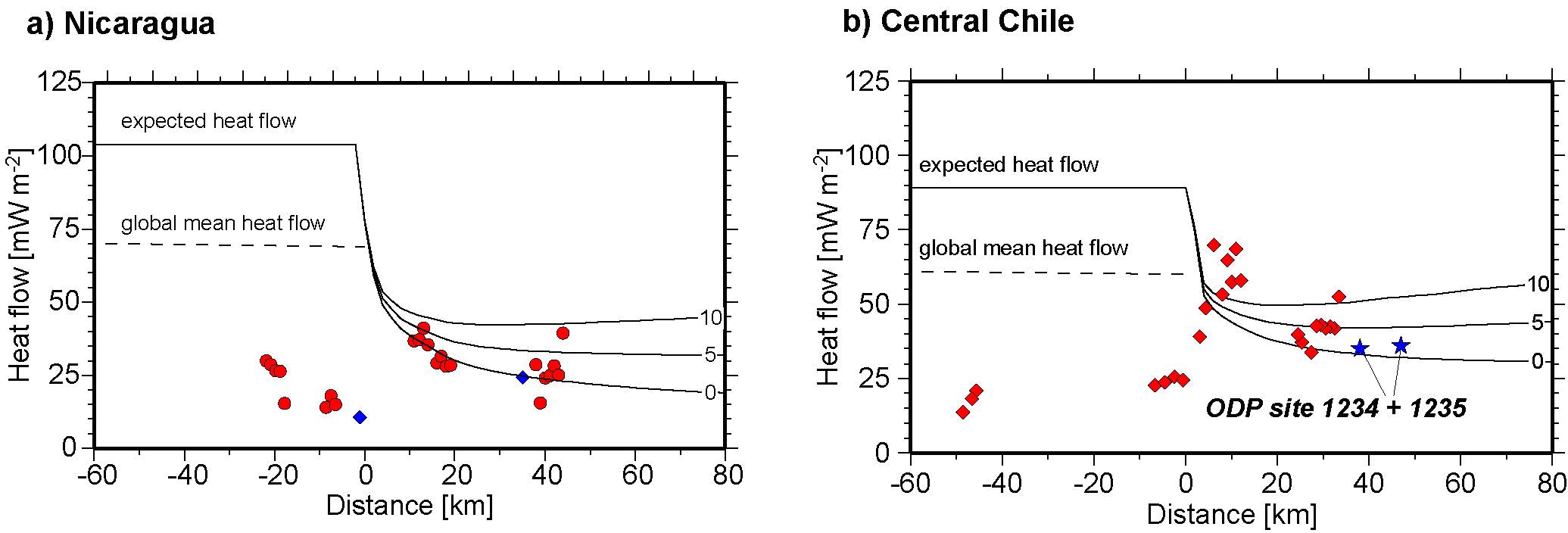 Web Content Display Web Content Display
Hydrothermal activity in the trench-outer rise prior to subductionAt subduction zones the oceanic lithosphere bends into the deep sea trench. Seafloor mapping and earthquake mechanisms in this area are consistent with bending-related normal faulting, which is suggested to provide the pathways for fluids to enter the crust and mantle. Therefore, it has been speculated that heat flow seaward of the trench may be low compared to that for average crust of the same age, due to increased hydrothermal circulation. However, Stein (2003) used a global but sparse heat flow data set and show no significant differences between heat flow near trenches and the global means for the same age crust. Combining data obtained within the framework of SFB574 and a project in Chile (CHASTE - DFG grant GR1964/4-1) we used swath mapping bathymetry and heat flow surveys across normal faults caused by plate bending offshore of Nicaragua (Fig. A5-2) and Central Chile to search for evidence indicating increased hydrothermal mining of heat and possibly hydration of the plate prior to subduction. In both survey areas (Fig. A5-4) heat flow values were lower than the expected conductive lithospheric heat loss and lower than the global mean for crust of that age. The low heat flow is interpreted to indicate increased hydrothermal circulation by the reactivation and new creation of faults prior to subduction, contradicting the global approach of Stein (Heat flow and flexure at subductionzones, Geophys. Res. Lett., 30, doi:10.1029/2003GL018478, 2003), which failed to detect similar features in the global but sparse data set. Detailed inspection of the global data set suggests that the thickness of the sedimentary blanket on the incoming plate is an important factor controlling the local hydrogeological regime. Areas with a relatively thick sedimentary cover do not show any heat flow anomaly while areas where normal faulting exposes basement suffer from increased hydrothermal activity. It is reasonable to assume that hydrothermal circulation causes serpentinization of the upper mantle, facilitated by bending-related faults cutting into the upper mantle. Results are published by Grevemeyer et al. (Heat flow and bending-related faulting at subduction trenches: case studies offshore of Nicaragua and Central Chile, Earth Planet. Sc i. Lett., 236, 238-248, 2005).
Fig. A5-3: Heat flow data offshore Nicaragua and central Chile are significantly reduced with respect to both the plate cooling model and global mean heat flow, indicating hydrothermal activity in the trench-outer rise. |
 Events Events
Kieler Wissenschaftler fühlen den 'Puls der Erde' Wie funktioniert die Recyclingmaschine der Erde?Nach elf Jahren endet der Kieler Sonderforschungsbereich 574 zu Subduktionszonen Final colloquium of SFB 574 Teilprojekt ÖffentlichkeitsarbeitMEERESFORSCHUNG FÜR MICH UND DICH |
|
©SFB574 // Wischhofstrasse 1-3 // D-24148 Kiel // T. +49 (0)431 600 1413 // elange [AT] geomar.de






